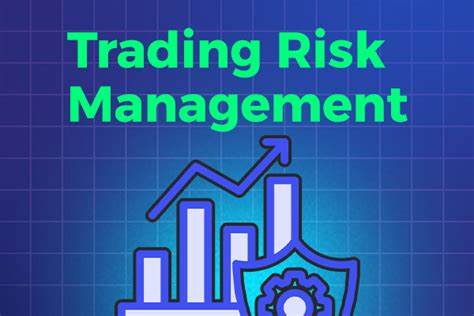
By ATGL
Updated January 23, 2025
In the high-stakes world of trading, even seasoned professionals can face significant financial peril. With unpredictable market movements, understanding and managing risk becomes essential for both survival and success.
Trading risk management not only safeguards your investments but also enhances your decision-making capabilities, enabling you to trade with confidence. An effective risk management strategy can benefit traders at every skill level, providing peace of mind in an otherwise chaotic environment.
This article delves into the core concepts of risk management in trading, exploring vital techniques and tools aimed at helping you navigate the markets effectively. From diversification to emotional discipline, and essential risk control measures, we’ll equip you with the knowledge to enhance your trading strategies.
What Is Trading Risk Management & Why Is It Important?
Trading risk management involves steps to keep trading outcomes financially bearable. This protects traders from unaffordable losses. Understanding and managing trading risks is crucial. It helps traders use strategies to lessen potential losses.
A crucial part of risk management is understanding the risk reward ratio, which helps traders evaluate whether the potential profit of a trade justifies the potential loss. By consistently aiming for favorable risk-reward setups, traders can maximize their gains while minimizing exposure to significant losses. Additionally, traders should consider the market risk premium—the additional return expected for taking on higher market risks. Recognizing this concept allows traders to determine whether the potential rewards align with the risks inherent in the broader market.
A solid risk management strategy helps traders weigh potential gains against risks. This leads to better trade decisions. Different strategies fit different trading situations and products. This shows the need for a tailored approach.
Risk management is vital for all traders, from day traders to retail investors. It builds long-term success by identifying and managing inherent risks.
Key Points of Trading Risk Management:
- Assess Potential Losses: Gauge what you can afford.
- Set Risk Tolerances: Know your risk comfort level.
- Use a Trading Plan: Guide your decisions.
- Apply Tailored Strategies: Fit strategy to situation.
| Risk Management Aspect | Importance |
|---|---|
| Trade Outcomes | Financially Manageable |
| Strategy Application | Mitigate Risks |
| Long-term Success | Manage Inherent Risks |
Overall, effective risk management plays a key role in trading, helping traders face market uncertainties with confidence.
Common Techniques for Managing Trading Risks
Active traders employ various techniques to manage risks effectively. These strategies help limit potential losses and secure profits, ensuring the sustainability of their trading activities. By setting stop-loss and take-profit points, traders can protect their investments while capitalizing on market movements. The 1% rule advises traders never to risk more than 1% of their total account value on a single trade. This approach safeguards overall capital and prevents devastating losses. Diversifying assets helps spread risks across multiple instruments, reducing potential significant losses in a trader’s portfolio. Developing a robust risk management strategy is vital for understanding and addressing trading risks. Regularly reviewing and adjusting these strategies ensures adaptability to changing market conditions.
Diversification
Diversification is a dynamic strategy that requires constant adjustments. This involves modifying your investment portfolio in response to market changes and individual financial goals. Balancing diversification minimizes risk while maximizing growth opportunities. Effective diversification includes owning non-correlated assets. This reduces overall risk without cutting expected returns. Traders must continuously observe and adjust diversification strategies to match their risk tolerance and investment objectives. This helps them navigate financial market fluctuations more successfully.
Hedging
Hedging is another key risk management strategy. It involves creating offsetting positions to mitigate potential losses in primary investments. A common hedging approach is opening opposite positions on the same asset, thus safeguarding against adverse market movements. Protective puts serve as hedging instruments, allowing investors to gain when their primary investments lose value. In the currency market, traders hedge by investing in gold or other precious metals, typically moving inversely to fiat currencies. Traders often seek assets like the JPN225 Index, which tends to counterbalance primary trades, such as the US Dollar/Japanese Yen.
Emotional Discipline
Emotional discipline is crucial in trading. Emotional interference poses significant risks, often leading to decisions that stray from established trading plans. Successful traders maintain emotional control, sticking to their strategies regardless of market conditions. A sound trading plan helps avoid emotional decision-making by keeping traders focused during market volatility. Managing emotions is considered the hardest part of trading. Impulsivity, fear, and greed can overwhelm traders, leading to poor decisions that hamper success.
Regular Reviews and Adjustments
Regular reviews and adjustments of risk management strategies are crucial. They ensure strategies remain efficient and responsive to ever-changing market conditions. Continuously reassessing methods helps traders maintain relevance and efficacy as markets shift. Staying informed about developments, such as data updates and geopolitical events, is essential for strategy adjustments during reviews. Evaluating current strategies against the market environment provides insights into their success and identifies improvement areas. Regular assessments help pinpoint new risks and opportunities, enabling proactive portfolio management.
Position Sizing
Position sizing is vital in managing trading risk. Fixed percentage position sizing involves calculating trade size so that a loss at the initial stop-loss level equals a set percentage of account funds, often 1% or 2%. The size of a trade directly impacts risk. For example, a 1,000-share position carries double the risk of a 500-share one if each share has a $1 risk. Smaller positions reduce risk exposure, allowing traders to increase size with familiar, high-probability setups. A predetermined stop-loss ensures that with defined risks, traders can maintain desirable risk-reward ratios, such as setting a stop-loss at $10 for a long position with a $13 target. Determining appropriate position sizes and stop-loss levels is essential as these factors play a critical role in managing risk and ensuring long-term profitability.
Table: Key Risk Management Concepts
| Concept | Definition |
|---|---|
| Stop-loss Point | A predetermined price at which a trade is closed to prevent further losses. |
| Take-profit Point | A target price at which a trade is closed to secure profits. |
| 1% Rule | A guideline advising traders not to risk more than 1% of their capital on a single trade. |
| Diversification | The practice of holding a range of non-correlated investments to reduce risk. |
| Hedging Strategy | The creation of offsetting positions to protect against losses in primary investments. |
| Emotional Control | The ability to remain rational and follow trading plans without succumbing to emotions. |
| Position Sizing | Determining trade sizes to control risk exposure and adhere to risk-reward targets. |
In conclusion, understanding and effectively managing trading risks is crucial for successful trading. By employing a mix of diversification, hedging strategies, emotional discipline, regular strategy reviews, and proper position sizing, traders can enhance their ability to navigate volatile markets. These fundamental techniques help ensure long-term success in trading activities.
Trading Risk Control: Useful Tools
In trading, risk management plays a key role in protecting your trading capital. Successful traders use various tools to control potential losses and secure potential profits. This includes a well-structured trading risk management plan which keeps risk tolerances in check. Implementing prudent risk management strategies can prevent unexpected setbacks. Traders must control risk exposure by understanding market risk and potential risks. Setting a loss level through stop-loss orders, defining a risk-per-trade with the one-percent rule, and establishing a daily loss limit are effective methods to manage these elements.
Stop-Loss Orders
Stop-loss orders are a crucial part of trading risk management. They help traders exit positions when the price moves unfavorably, preventing an unmanageable loss. A stop-loss order can be set below the current price in the case of a sell position. This is activated once the market falls to the pre-determined stop price. Automatic stop-loss orders manage losses without involving emotions, as they are executed at a certain loss level. Proper stop-loss orders balance risk and reward and allow room for minor price movements. Along with take-profit orders, they defend investments from losses and secure profits at target levels.
Risk-Per-Trade
The risk-per-trade strategy involves never risking more than 1% of your trading capital on a single trade. This principle shields traders from excessive losses. Calculating risk per trade according to personal preference and circumstances is vital. This often suggests a risk limit ranging from 1% to 10% of total capital. Establishing a maximum loss for each trade, or for each day or week, is crucial. It helps avoid significant depletion of your account, ensuring long-term sustainability. A successful trading strategy relies on a thorough risk management plan, especially if leverage is involved since it can amplify losses and profits. The effectiveness of these strategies depends on disciplined execution, adhering strictly to defined risk limits.
Daily Loss Limit
Setting a daily loss limit is an essential risk management strategy. It prevents significant portfolio damage by requiring traders to halt trading once the limit is hit. This limit can be either dollar-based or percentage-based. It helps preserve trading capital and prevents emotional trading induced by market stress. Traders understand that some days are more challenging than others. Having a daily loss limit allows traders to walk away and reassess strategies when necessary. It precludes emotional stress and the urge to chase losses on tough days. A daily loss limit enables traders to maintain control over their risk levels and achieve successful trading outcomes.
Another invaluable tool is the use backtesting strategy, which involves testing a trading strategy using historical data to evaluate its effectiveness. By backtesting strategies, traders can identify potential weaknesses, refine their approach, and gain confidence in their trading plan before risking real money.
Overall, having a firm grasp on risk management trading tools like stop-loss orders, risk-per-trade limits, and daily loss limits can lead to disciplined trading. These elements keep trading decisions fact-based, minimizing the impact of emotions. They allow traders to survive the ups and downs of the financial markets while protecting their capital from systemic risks. By understanding and using these strategies effectively, traders can control potential risks, manage risk tolerances, and increase their chances of successful trading. Employing a trading plan incorporating these elements ensures a structured approach to the financial markets, helping traders to harness market opportunities prudently.
What Mistakes Should Traders Avoid?
Navigating the financial markets can be daunting. Successful trading involves more than just buying and selling. To thrive in this environment, traders must avoid common pitfalls. Understanding these mistakes is crucial for risk management trading and can make a significant difference in a trader’s long-term success. Let’s explore these errors and how to avoid them.
Emotional Trading
Emotions like fear and greed often cloud judgment. Emotional trading stems from impulsive decisions, putting a trader’s plan at risk. Successful traders know emotions can trigger losses, especially after a winning streak. Managing emotions is crucial. Developing a solid trading plan helps traders stick to logical strategies. This plan prevents reckless behavior and emotional interference, ensuring a trader can objectively assess market conditions and make sound trading decisions.
Trading Without a Plan
Trading without a plan can be akin to gambling. Without setting stop-loss or take-profit points, traders let emotions like excitement and fear take control. This approach often leads to substantial losses. A successful trading plan involves discipline. Traders must adhere to predetermined guidelines, including setting maximum loss levels and risk limits per trade. Without this structure, traders risk losing capital and may find it hard to recover from losses.
Overtrading
Overtrading occurs when traders hastily enter positions without clear points for profit or loss. This can lead to emotional decisions and increased risk. Successful traders analyze their trading strategy’s win-loss ratio to inform their risk management strategy. Many day traders follow the one-percent rule—limiting each position to 1% of their total capital. Setting limits on open positions in related instruments helps avoid concentration risk. Effective risk management allows traders to limit losses and trade without constant fear of financial setbacks.
Failing to Cut Losses
Not cutting losses can lead to unexpected large losses, especially without a stop-loss in place. Undisciplined traders might hope to break even, worsening their financial situation. Evaluating potential losses against profits prevents risky trades with low profit potential. Stop-loss orders help traders define loss limits before trading. A common strategy is risking no more than 2% of total capital per trade. Ignoring these practices results in excessive risk-taking and can jeopardize financial stability.
Enhance Your Trading and Risk Management with Above the Green Line
Effective risk management is essential in futures trading for success and peace of mind. Above the Green Line emphasizes using only risk capital—money you can afford to lose without affecting your lifestyle. This approach safeguards you from life-altering financial stress.
To limit potential losses, setting stop-loss orders is critical. These orders exit trades at predefined price levels, enhancing your overall risk management strategy. Ensure that capital levels are sufficient to cover margin calls, preventing financial overextension when leveraging trades.
Adopt a consistent and disciplined trading approach. This prevents overtrading, especially after a streak of successful trades. Below is a simple checklist to enhance your trading strategy:
- Use Risk Capital: Invest only what you can afford to lose.
- Set Stop-Loss Orders: Limit potential losses proactively.
- Maintain Sufficient Capital: Cover margin calls.
- Stay Disciplined: Avoid the temptation to overtrade.
Maintaining a clear risk management strategy enables long-term success without compromising your financial stability. Always remember, prudent risk management and disciplined trading are key pillars of success with Above the Green Line.
FAQs About Risk Management in Trading
Understanding risk management is vital for traders looking to succeed in financial markets. Below are some common questions and answers.
What is the 2% rule in trading?
The 2% rule suggests that traders should not risk more than 2% of their trading capital on a single trade. This limits potential losses and helps preserve capital over time.
What is the best risk management strategy for trading?
There isn’t a one-size-fits-all strategy. However, successful traders often combine stop-loss orders, reward ratios, and prudent risk management to control risk levels. Developing a trading plan that matches your risk tolerances is key.
What is the 3-5-7 rule in trading?
The 3-5-7 rule is a guideline for setting profit targets and stop-loss levels. It encourages traders to aim for potential profits that are three times the risk, cut losses after a 5% decrease, and reassess strategies after a 7% loss.






